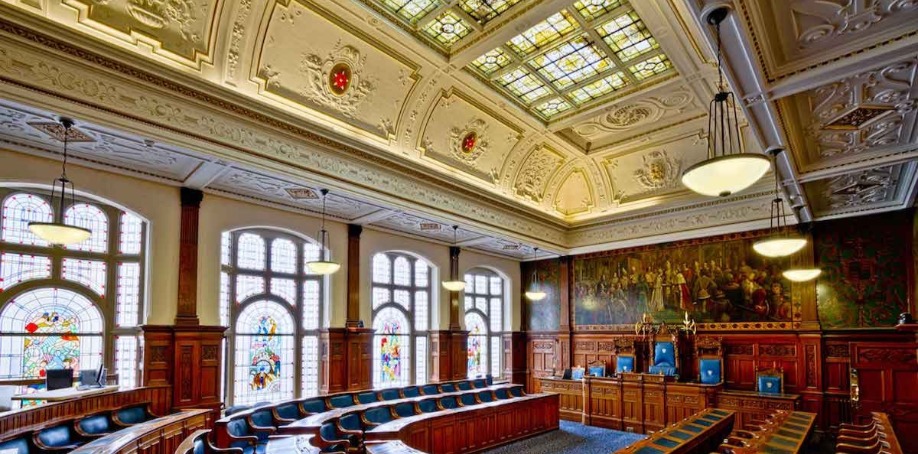
Preserving historic buildings isn't just good aesthetic or historic sense; often, it's good environmental sense as well. As the Whole Building Design Guide notes, restoring or rehabilitating a historic building saves the energy required to tear down and rebuild, and the results can be as energy-efficient and functional as a new building would be.
Nevertheless, bringing a historic building up to today's standards — including in its digital functionality — poses unique challenges for AV integrators. Here, we look at some of the biggest hurdles and how integrators can address them.

Bringing Past Buildings Into the Present: Major Challenges
When the decision is made to make a historic building useable for present purposes, a host of questions arise. The National Park Service breaks this starting point into four categories:
- Preservation: How can we keep the building “as is” for future generations to appreciate the past?
- Rehabilitation: How can we bring the building “up to date” for modern use?
- Restoration: How can we keep the building “as was” by removing later additions or alterations?
- Reconstruction: How can we restore parts of the building that have not survived?
In nearly all situations, AV integrators will be asked to participate in rehabilitation of historic buildings. The overall goal: To make the space functional for today's users while maintaining key parts of its original structure or character. Damage to historic walls, windows, floors, paneling or similar features is to be avoided, according to The Secretary of the Interior's Standards for the Treatment of Historic Properties.
The first challenge integrators face, then, is physical. How can cabling be run, screens installed and speakers hung when the location of the building's physical features takes precedence — and when those features, erected dozens or hundreds of years earlier, in no way accommodate today's digital demands?
One of the benefits of AV over IP is its ability to leverage existing IT networks to transmit crystal-clear video and audio. In a historic building, however, both Ethernet cabling and wi-fi hotspots can be baffling at best, notes Ricky Ribeiro at BizTech.
Wireless options have made networking easier in some buildings. For instance, Fresno City College's 100-year-old administration building had to be brought up to code in order to handle the city's periodic earthquakes — resulting, at some points, in walls three to four feet thick, says Harry Zahlis, the college's interim director of technology. Running Ethernet cabling wasn't an option, so the college turned to wireless access points instead.
Even wireless can pose trouble in some historic structures, however. Boston Red Sox IT director Steve Conleycompared placing the historic ballpark's DAS nodes to an Easter egg hunt. Conley noted how, even after the boxes were in place, the park's “back office” work used a great deal of its connectivity.
And behind every wireless system, there are wires.
“People don't realize the hardest piece to install is the wiring to plug in access points,” says security consultant Eric Smith. “A campus like ours has 150-year-old buildings. They were not designed to pull Ethernet cables from one side of a building to another. You burn up a lot of time and expense to get cables from A to B.”
The placement of cables and access to them matters to AV integrators, who often have no choice but to plug into the Ethernet cabling in order to provide top-quality streaming and other services.
The fiber optics industry is providing options that may expand integrators' flexibility and options in historic spaces. As John George, Anurag Jain, and Laura Werner note in Lightwave, installing fiber optic cabling in residential spaces poses similar challenges to installation in historic ones: Residents don't want to see the cables, but they also don't want holes cut into their walls and ceilings for installation, even if those holes will be patched.
One answer? Transparent cables less than 1 mm in diameter, flexible enough to traverse nearly any architecturally-complex space. Integrators who have the opportunity to recommend or use such tools gain greater flexibility in what they can offer potential clients and what they can deliver.

Tips for Integrators During Bidding and Installation
Since so much of the historic “weight” of a building is tangible, integrators who wish to bid on projects in historic structures stand a better chance of landing the work if they understand how a building's rehabilitation affects and is affected by technology installation, including AV over IP installation.
For better bidding:
- Understand rehabilitation guidelines. The Department of the Interior's general guidance on rehabilitating historic buildings allows for new or non-time-period-specific materials to be used when a historic building is rehabilitated for modern use. This leeway opens up options for materials used in AV over IP installations as well, from mounting surface considerations to materials used to create space for cabling or other equipment.
- Know what matters in the space. When asked to rehabilitate the old Levi Strauss jeans factory into a school, the architects at Pfau Long knew that maintaining the patina of the old wooden factory floors was a must. Find out from the client which architectural features are most important to preserve, which are available for alteration, and which are likely to be demolished or rebuilt. This knowledge will open up options for meeting installation challenges.
- Work with IT to build a map of the network and its pitfalls. IT staff may already have a map of wi-fi “dead zones,” major obstacles to cabling, and more. The better your sense of where the building interferes with the network, the easier it will be to compensate, notes tech writer Max Cooter at Aerohive.
- Leverage the latest options. Business strategist Rob Ziv described a project at at Sound & Communications that entailed installing additional microphones in a historic courthouse — a build that would have been a nightmare in the days when each microphone demanded its own cable, yet the ability to pass that many cables through the walls was practically nonexistent. The 21st century answer: To connect all the microphones to a single controller within each courtroom, then pass the controller's single cable through the limited wall space. Tools like these can allow AV over IP integrators to offer more functionality while taking less of a toll on the building.
During the installation phase, integrators may need to get creative with their use of the historic building's existing architectural features and space in order to install equipment without disrupting key building features. While few historic buildings were designed with the drop ceilings and other features that make installations easier in new buildings, they often have now-disused architectural features that can be repurposed to run cable or install equipment, as Jack Gehring and Dan Hanlon note in Cabling Installation & Maintenance. For example:
- Where utility pathways exist, consider using them for cabling as well.
- Existing but unused chimney flues can often house cables or equipment.
- Floor channels, false ceilings, or hollow moldings can all help disguise cables and connections.
- Architectural elements may be used in some spaces to conceal equipment like speakers without disrupting functionality.
Installing AV over IP systems in historic buildings poses a creative challenge, but the results can be satisfying for both integrators and clients.
Images by: Meriç Dağlı, Michael D. Beckwith, Jonathan Francisca


